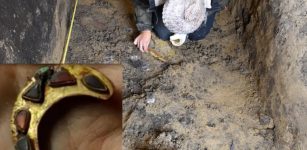Tusayan Pueblo Ruins And Split Twig Figurines Tell Story Of People Who Once Inhabited The Grand Canyon
A. Sutherland - AncientPages.com - People have continuously occupied the Grand Canyon for at least the past 4,000 years, and they have lived in the region for the past 12,000 years. As many as 4,800 archaeological sites have already been documented, but many more still remain to be cataloged.
Over the centuries people have come and gone in and around the Grand Canyon area, occupying it for extended periods of time or staying there only briefly.
The Ancestral Puebloans, who are believed to be relatives of the modern-day Zuni, Hopi, and other Puebloan tribes, established roots at the Grand Canyon.
The Tusayan Ruins (also known as ‘Tusayan Pueblo’) are the remains of a small 12th century Ancestral Puebloan village site located within Grand Canyon National Park, Arizona. It is one of the best-documented archaeological sites of the region.
The ruins are considered to be one of the major archeological sites in Arizona.

Anasazi food storage building ruins at Tusayan Pueblo — Grand Canyon area/Large kiva Image via Wikipedia
Both the ruins of the village and the local Tusayan Museum that displays pottery, seashell bracelets, corncobs, arrowheads along with original split-twig figurines, give us an insight into the lives of a thriving Anasazi community with a rich history.
Historians believe that the Tusayan settlement numbered only about 30 people and was in occupation for only a quarter of a century.
They made their own tools, whether for cooking or hunting, from stone, bone, and antler. Stone grinders were used by them to grind corn and stone arrowheads were used as weapons.

Split twig figurines – an important part of the Desert Culture – represent the oldest record of human occupancy of the Grand Canyon, some dating back to at least 4,000 years. Researchers believe that the small effigies depict several animals very common in the Grand Canyon even today.
It is believed that the effigies were made as part of a ritual ceremony that was carried out before a hunt, to ask for the blessings of the animal’s spirits before taking their lives.
The so-called split twig figurines (image above) date back 2,000 to 4,000 years. They were not found at Tusayan Ruin itself, however, these artifacts were discovered in many other caves in the Grand Canyon. They provide proof of the long human presence at the Grand Canyon and its use by Native Americans.
The ‘Tusayan Pueblo’ settlement consisted of a central plaza surrounded by living quarters, kivas, and storage rooms. The plaza faced south to catch the sun during cooler seasons.
The living quarters consisted of a single story of rock, adobe, and wood with about 3 or four main rooms. Storage rooms held food that was dried to preserve it during harsh winter months.
The only source of transportation for these Anasazi people was on foot. Everything that these people ate had to be gathered, harvested, or killed by them.

The walls of ancient rooms where villagers stored food and other items can still be seen along the Tusayan Ruin trail near the Tusayan Museum. Photo: Sarah Bohl. via ASU
Among ruins there are still preserved ceremonial structures, that modern Puebloans use even today in diverse festivals and religious ceremonies. The structures are believed to represent the Sipapuni, a geological feature on the floor of the Grand Canyon that many Hopi believe is the place where they entered into this world.
These people lived during the Pueblo II Period (900 AD to 1150 AD), which was the second pueblo period of the Ancestral Puebloans of the Four Corners region of the American southwest. They managed to survive into the Pueblo III era, an important period in the development of Puebloan communities, which gradually began to build multi-storied pueblo or cliff-side talus house communities and lived in large cliff-dwellings.
Written by – A. Sutherland - AncientPages.com Senior Staff Writer
Copyright © AncientPages.com All rights reserved. This material may not be published, broadcast, rewritten or redistributed in whole or part without the express written permission of AncientPages.com
Expand for referencesMore From Ancient Pages
-
 Ancient Colorful Nile-Scene Mosaics, Plastered Walls, Water Cistern Unearthed On The Shore Of The Sea Of Galilee
Archaeology | Sep 27, 2022
Ancient Colorful Nile-Scene Mosaics, Plastered Walls, Water Cistern Unearthed On The Shore Of The Sea Of Galilee
Archaeology | Sep 27, 2022 -
 Did Roman Fortifications On Eastern Frontier Function As A Wall Or A Road?
Places | Feb 16, 2024
Did Roman Fortifications On Eastern Frontier Function As A Wall Or A Road?
Places | Feb 16, 2024 -
 A Warrior’s Princely Tomb With Artifacts Unearthed In Romania
Archaeology | Dec 27, 2022
A Warrior’s Princely Tomb With Artifacts Unearthed In Romania
Archaeology | Dec 27, 2022 -
 Mystery Of The Lost Biblical City Of Ai – Where Was It Located?
Ancient Mysteries | Apr 23, 2017
Mystery Of The Lost Biblical City Of Ai – Where Was It Located?
Ancient Mysteries | Apr 23, 2017 -
 On This Day In History: Sack Of Rome Took Place on May 6, 1527
News | May 6, 2016
On This Day In History: Sack Of Rome Took Place on May 6, 1527
News | May 6, 2016 -
 Gunung Padang – Remarkable Megalithic Site In Indonesia
Civilizations | Jun 14, 2014
Gunung Padang – Remarkable Megalithic Site In Indonesia
Civilizations | Jun 14, 2014 -
 Cimmerians – Ancient People Searching For A Home
Civilizations | Feb 11, 2019
Cimmerians – Ancient People Searching For A Home
Civilizations | Feb 11, 2019 -
 Unique Roman Artifact Discovered At Vindolanda Was More Than A Good Luck Charm
Archaeology | Feb 20, 2023
Unique Roman Artifact Discovered At Vindolanda Was More Than A Good Luck Charm
Archaeology | Feb 20, 2023 -
 Long-Lost Home Of Harold, The Last Anglo-Saxon King Of England Found On Depicted On The Bayeux Tapestry
Archaeology | Jan 28, 2025
Long-Lost Home Of Harold, The Last Anglo-Saxon King Of England Found On Depicted On The Bayeux Tapestry
Archaeology | Jan 28, 2025 -
 Deadly Ancient Secrets Of Queen Hatshepsut’s Flacon
Artifacts | Mar 18, 2017
Deadly Ancient Secrets Of Queen Hatshepsut’s Flacon
Artifacts | Mar 18, 2017 -
 Why Do Some Men Think Often About The Roman Empire?
News | Oct 4, 2023
Why Do Some Men Think Often About The Roman Empire?
News | Oct 4, 2023 -
 Large 4th Century Mosaic Floor Unearthed In İncesu, Kayseri Province, Turkey
Archaeology | Nov 28, 2023
Large 4th Century Mosaic Floor Unearthed In İncesu, Kayseri Province, Turkey
Archaeology | Nov 28, 2023 -
 Ancient Scandinavians Never Spoke Of Themselves As Vikings – Here Is Why
Ancient History Facts | Mar 15, 2021
Ancient Scandinavians Never Spoke Of Themselves As Vikings – Here Is Why
Ancient History Facts | Mar 15, 2021 -
 DNA In Viking Poop Sheds New Light On 55,000-Year-Old Relationship Between Gut Companions
Archaeology | Sep 5, 2022
DNA In Viking Poop Sheds New Light On 55,000-Year-Old Relationship Between Gut Companions
Archaeology | Sep 5, 2022 -
 Unique Well-Preserved 16th-17th Century Fabrics And Shoes Found In Toruń, Poland
Archaeology | May 13, 2024
Unique Well-Preserved 16th-17th Century Fabrics And Shoes Found In Toruń, Poland
Archaeology | May 13, 2024 -
 Did Ancient Romans Reach The Americas Long Before Columbus?
Civilizations | May 19, 2021
Did Ancient Romans Reach The Americas Long Before Columbus?
Civilizations | May 19, 2021 -
 Mysterious Ancient Circular Structure Discovered In Turkey – Has Zippalanda, The Lost City Of The Hittites Been Found?
Archaeology | Dec 27, 2022
Mysterious Ancient Circular Structure Discovered In Turkey – Has Zippalanda, The Lost City Of The Hittites Been Found?
Archaeology | Dec 27, 2022 -
 Mystery Of The Amazing 2,500-Year-Old Underwater Rochelongue Treasure
Featured Stories | Jul 7, 2023
Mystery Of The Amazing 2,500-Year-Old Underwater Rochelongue Treasure
Featured Stories | Jul 7, 2023 -
 Battle Of Abrittus: Roman Emperor Decius And His Troops Ambushed And Defeated By Invading Goths
Featured Stories | Jul 1, 2019
Battle Of Abrittus: Roman Emperor Decius And His Troops Ambushed And Defeated By Invading Goths
Featured Stories | Jul 1, 2019 -
 1,200-Year-Old Wari Temple Discovered In Peru
Archaeology | Feb 24, 2023
1,200-Year-Old Wari Temple Discovered In Peru
Archaeology | Feb 24, 2023

